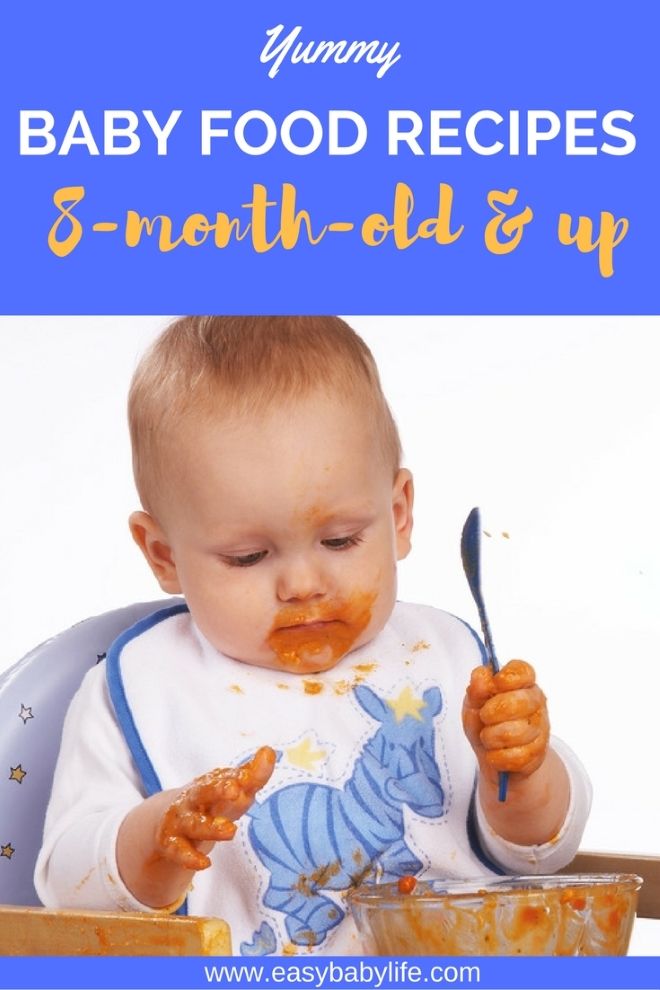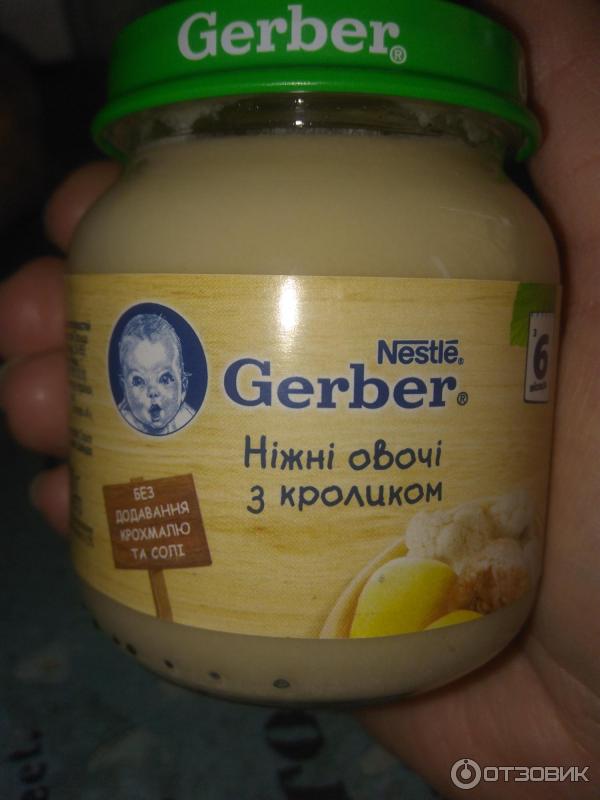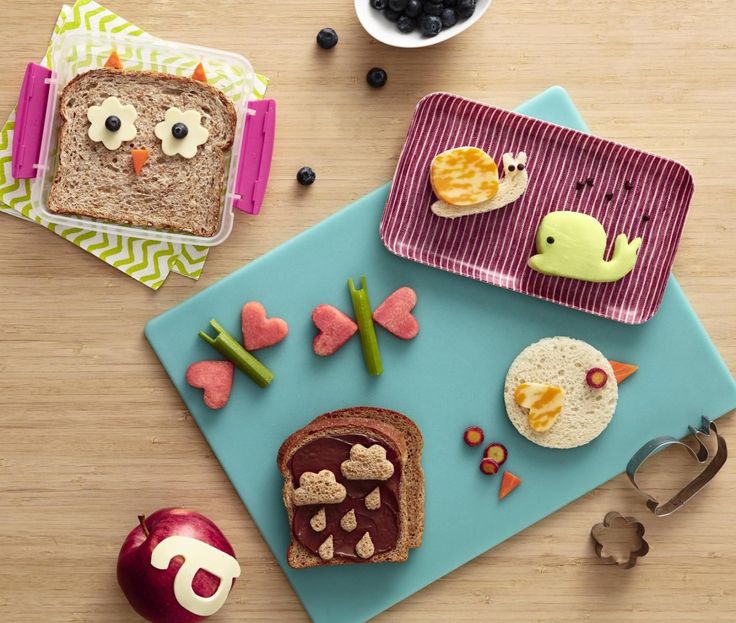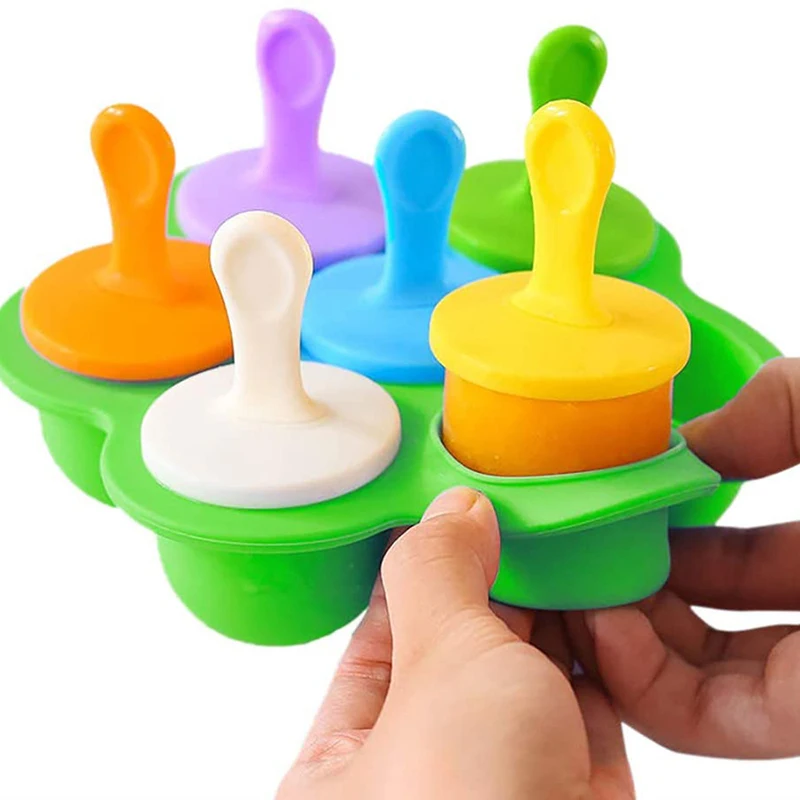Baby food chart after 6 months in bengali
শিশুর ফুড চার্ট ও রেসিপি
তিতিরসোনা পুঁচকে হলে কী হবে? গলায় জোর কিন্তু মোটেই পাখির মতো নয়। আর ছোট থেকেই খাবার নিয়ে তার ভয়ানক বায়নাক্কা। মায়ের দুধে তার পেট ভরতো না বলে, ডাক্তারের পরামর্শে ওর মা রিদ্ধিমা ওকে বুকের দুধ ও ফরমুলা মিলিয়ে মিশিয়ে খাওয়াত সারাদিনে। এই ফরমুলা খাওয়াতে গিয়ে যেন ঘেমে নেয়ে একসা হয়ে যেত মা বেচারি। (6 Months Baby Food Chart And Recipes)
মেয়ে গত সপ্তাহেই ৬ মাসের হয়ে গেছে, তুরতুরিয়ে বড় হচ্ছে; এই কথা ভেবে রিদ্ধিমা যেমন আনন্দ পাচ্ছে; অন্যদিকে তিতিরের খাবারের ব্যাপারে চিন্তা করে তার মনে ভয় কিন্তু কম নেই। (Introducing Solids) বাড়ির গুরুজনেরা যতই পরামর্শ দিন না কেন, রিদ্ধিমা তো জানে, তার তিতিরপাখি চ্যাঁ-ভ্যা না করে একটা দানাও মুখে তুলবে না (6 Maser Bachhar Khabar o Recipe)।
কিন্তু এবার তো সলিড খাবার খাওয়ার অভ্যেস শুরু করাতেই হবে তিতিরকে। না হলে ও যে সম্পূর্ণ পুষ্টি পাবে না। আর যে মেয়ের ফরমুলা খাওয়া নিয়ে এত প্রতিবাদ, সে নুন-চিনি-মশলা ছাড়া সেদ্ধ খাবার খাবে কীভাবে (Starting Solids at 6 months), এই ভেবেই চোখের তলায় কালি জমছে তিতিরের মায়ের।
শুধু তিতিরের মা কেন, আপনিও যদি এক ৬ মাসের ছানার মা হন, আপনার মনেও এসব প্রশ্ন আসতে বাধ্য। এতদিন তো শুধু বুকের দুধ বা ফরমুলাতেই হয়ে যেত, কিন্তু এবার পরিবর্তন আসবে বাচ্চার খাবারে। (Introducing Solids to Your 6 month to 8 month old Baby) সলিড খাবারের সাথে ধীরে ধীরে পরিচিত করে তুলতে হবে ওকে।
কীভাবে খাওয়াবেন, কতটা খাওয়াবেন বা কখন খাওয়াবেন, এই ধরনের নানান প্রশ্ন বিভ্রান্ত করে তোলে নতুন মায়েদের। যারা রিদ্ধিমার মতো বর আর বাচ্চাকে নিয়ে একলা থাকে, তাদের মুশকিল যেন আরও বেশি। আজ সেই মায়েদের কথা ভেবেই আমাদের এই প্রতিবেদন। (Complete Guide to Starting Baby on Solids)
বাচ্চার বয়স ৬ মাস হয়ে গেলে সার্বিক পুষ্টির জন্য তাকে কী কী খাওয়ানো উচিত? কখন কখন খাওয়াবেন এবং কতটা পরিমাণে খাওয়াবেন।কীভাবে খাবার বানালে সেদ্ধ এবং ঘাঁটা খাবারেও আসবে একটু স্বাদের ছোঁয়া; আজ এইসব কিছু নিয়ে কথায়, ছবিতে সাজিয়ে দিলাম প্রতিবেদন (6 Months Baby Food Chart with Baby Food Recipes)। তা ছাড়াও, ৬ মাসের বাচ্চার প্রথম শক্ত খাবার বানানোর সহজ পদ্ধতি বোঝাতে সঙ্গে রইলো একখান ভিডিও। পড়ে নাও, দেখে নাও আর শুনে নাও তোমার ৬ মাসের পুঁচকের খাতিরে।
৬ মাসের বাচ্চাকে কী কী খাবার দেওয়া যায়? (Foods for 6 Months Old Baby)
বাচ্চার বয়স ৬ মাস হয়ে গেলে মোটামুটি যেসব খাবার দিয়ে শুরু করতে পারেন,
- ফলের মধ্যে আপেল, কলা, নাশপাতি, অ্যাভকাডো, পিচ ফল দিতে পারেন। তবে ফল সেদ্ধ করে পেস্ট করেই দিন। কলার ক্ষেত্রে সেদ্ধ করার দরকার হয় না, মিহি পেস্ট করে দিতে পারেন।
- ডালের মধ্যে মুগ ডাল, মুসুরির ডাল সেদ্ধ বা ডালের জল বাচ্চাকে খাওয়াতে পারেন।
- সবজির মধ্যে মিষ্টি আলু, মিষ্টি কুমড়ো, আলু, গাজর, মটরশুঁটির মতো সবজি ভর্তা বানিয়ে বা স্যুপের মধ্যে চটকে বাচ্চাকে খাওয়ান (Sisur Khabar)।
- রাগি, বার্লি, ওটসের পরিজ এবং নরম ভাত রাখুন বাচ্চার খাদ্যতালিকায়।
৬ মাসের বাচ্চাকে দিনে কখন সলিড ফুড খাওয়াবেন?
(6 Month Baby Food Chart with Time)
বাচ্চা সবে সলিড খাবার খেতে শুরু করছে, তাই বলে খাওয়ার সময় হলেই ওকে সলিড খাবার দেবেন না যেন! ৬ মাসের বাচ্চার ডায়েটে সলিড ও বুকের দুধ/ফরমুলা থাকবে মিলিয়ে মিশিয়ে এবং নির্দিষ্ট কিছু সময়ের অন্তরে (6 Months Old Baby Food Chart)। ৬ মাসের বাচ্চাকে দিনে দু’বার যে কোনও সলিড খাবার দিলেই যথেষ্ট। আপনাদের বোঝানোর সুবিধার্থে নীচে একটি ফুড চার্ট (বাচ্চার খাওয়ার রুটিন/ খাদ্য তালিকা) দিয়ে দিলাম (Baby Meal Plan)। সময়ের আন্দাজ এতে হয়ে যাবে, আর ৬ মাসের বাচ্চাকে কী কী খাওয়াবেন, তার রেসিপিগুলোও সব দিয়ে দিচ্ছি এক এক করে।
৬ মাসের বাচ্চার জন্য পুষ্টিকর ও নরম (পরিজ) কিছু রেসিপি (Homemade Baby Food Recipes for 6 Months)
#1. ডাল সেদ্ধ: মুগ ডাল বা মুসুরির ডাল খুব ভালো করে ধুয়ে নিন। এবার প্রেসার কুকারে জল দিয়ে ২/৩ টি সিটি হওয়া পর্যন্ত অপেক্ষা করুন। কুকারের ভাপ খুলে গেলে ডাল অল্প ঠান্ডা হলে ব্লেন্ডারে মিহি পেস্ট করে নিন। বাড়িতে তৈরি খাঁটি ঘি সামান্য একটু ওই ডালের পেস্টে মিশিয়ে বাচ্চাকে খাওয়ান (6 Month Baby Food)।
#2. নরম ভাত: বাড়িতে যে ভাত খান, সেই ভাতই আরেকটু বেশি সেদ্ধ করুন আপনার খুদের জন্য। এবার সেদ্ধ ভাত, অল্প জল ব্লেন্ডারে দিয়ে মিহি পেস্ট করে নিন (Homemade Baby Food Recipes)। খাঁটি অরগানিক বাটার বা মাখন অল্প মিলিয়ে বাচ্চাকে ভাতের পেস্ট খাওয়ান।
#3. ভাত, আলুসেদ্ধ ও ডালের জল চটকে মাখা: ডালের জল, বেশ নরম করে গলানো ভাত আর সুসিদ্ধ আলু, সবকিছু একসাথে চটকে মিহি পেস্ট বানিয়ে নিন এবং বাচ্চাকে খাওয়ান (6 Months Baby Food Chart with Baby Food Recipes)।
#4. গ্লুটেন ফ্রি ওটস পরিজ: এই পরিজ বানানোর দুই রকম পদ্ধতি আছে।
পদ্ধতি ১->
উপকরণ:
- গ্লুটেন ফ্রি ওটস
- জল
- খাঁটি গুড়
প্রণালী:
- প্যানে জল গরম করে জল ফুটে এলে ওটস দিয়ে দিন।
- কিছুক্ষণ সেদ্ধ হওয়ার পর মিশ্রণটা থকথকে হয়ে এলে নামিয়ে নিন।
- যদি মনে হয়, ব্লেন্ডারে পুরো মিশ্রণটা একবার পেস্ট করে নিন।
- বাচ্চাকে খাওয়ানোর সময় সামান্য খাঁটি গুড় মিশিয়ে দিন (Meal Plan fo 6 Month Old Baby)। এতে মিষ্টি ভাব আসায় বাচ্চা সুন্দর খেয়ে নেবে।
পদ্ধতি ২-> এই পদ্ধতিতে আপনি বাচ্চাকে বাইরে নিয়ে গেলেও ওটস পরিজ খাওয়াতে পারবেন। বাইরে বেড়াতে গেলে বাচ্চা সলিড কী খাবে এই নিয়ে মাথা খারাপ করতে হবে না (Sisur Pustikor Khabar)।
উপকরণ:
- গ্লুটেন ফ্রি ওটস
- জল
- ফরমুলা মিল্ক বা বুকের দুধ
প্রণালী:
- ওটস ভালো করে ড্রাই রোস্ট করে নিন।
- এবার রোস্ট করা ওটস একটু ঠাণ্ডা হয়ে এলে ব্লেন্ডারে দিয়ে মিহি গুঁড়ো করে নিন।
- এয়ার টাইট কৌটোতে এই গুঁড়ো করা ওটস আপনি সংরক্ষণ করতে পারবেন।
- বাচ্চাকে খাওয়ানোর সময় ফরমুলা মিল্ক বা বুকের দুধ মিশিয়ে খাওয়ান।
- প্রয়োজন অনুযায়ী জল মেলাবেন। (Homemade Baby Food Recipes)
আরও অন্য পদ্ধতিতে বানানো ওটস পরিজ এবং ৬ মাসের বাচ্চার খাওয়ার মতো কিছু মজাদার রেসিপি রইলো সঙ্গের ভিডিওতে। দেখে নিন->
আরও পড়ুন: ছোট্ট ছানার জন্য সহজ-স্বাস্থ্যকর ১০ ধারার খিচুড়ির রেসিপি!
#5.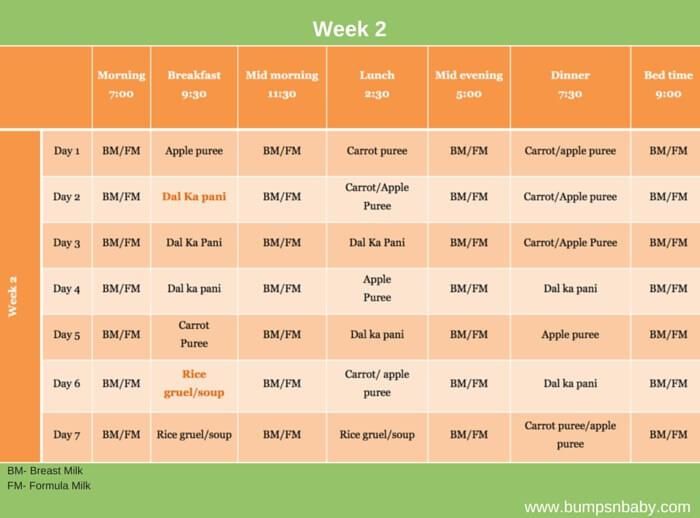 চাল এবং মুগ ডালের জাউ
চাল এবং মুগ ডালের জাউ
উপকরণ:
- চাল- তিন টেবিল-চামচ
- ডাল- দুই টেবিল-চামচ
পদ্ধতি:
- চাল ধুয়ে নিয়ে শুকিয়ে নিন, তারপর গুঁড়ো করুন।
- ডাল একটু ভেজে গুঁড়ো করে নিন।
- দুটোকে একসাথে মিশিয়ে নিন।
- গরম জলের মধ্যে মিশ্রণটা দিয়ে নাড়তে থাকুন কিছুক্ষণ (Six Month Baby Food)।
- থকথকে হয়ে এলে নামিয়ে নিন।
#6. আপেল ও রাগির জাউ
উপকরণ:
- রাগি আটা- দুই টেবিল চামচ
- অর্ধেক আপেল
পদ্ধতি:
- আপেলটা কেটে একদম গলিয়ে ফেলুন।
- রাগি আটা জলে মেশান এবং রান্না করুন।
- রাগি মিশ্রণ আর আপেলের মিশ্রণ একসঙ্গে মিলিয়ে নিন (Homemade Baby food Recipes)।
#7. নাশপাতির পিউরি: নাশপাতিকে ছোট ছোট টুকরোয় কেটে নিন। এবার ছুরি দিয়ে ঘষে বীজ গুলো ফেলে দিন। প্যানে জল নিয়ে নাশপাতির টুকরোগুলো সেদ্ধ করে নিন। এবার ব্লেন্ডারে একটা মিহি পেস্ট বানিয়ে নিন। ফরমুলা দুধ মিশিয়ে বাচ্চাকে খাওয়ান। যদি একটু পাতলা করতে হয়, তা হলে প্রয়োজনমতো জল মিশিয়ে নিন।
নাশপাতি দিয়ে ফলের পিউরি শুরু করলাম বটে (Homemade Puree for Babies), কিন্তু হাতের সামনে যে ফলগুলো সবসময় থাকে, তাদের পিউরি বানিয়ে দিতে ভুলবেন না যেন! রেসিপি রইলো ছবিতে->
বাচ্চার খাবারের পরিমাণ কতটা হবে? (How Much Baby Food Should a 6 Month Old Eat? )
৬ মাস বয়সে বাচ্চা প্রথম সলিড খাবারের সাথে পরিচিত হতে শুরু করে। প্রথমেই অনেকটা খাবার দেবেন না বাচ্চাকে। প্রথমে ৩-৪ চা চামচ পরিমাণ দিয়ে শুরু করুন (6-Month-Old Feeding Schedule)। বাচ্চার শরীর অভ্যস্ত হয়ে গেলে ধীরে ধীরে পরিমাণ বাড়াবেন।
কী কী বিষয়ে বিশেষ সতর্ক থাকবেন:
- ৬ মাসের বাচ্চার জন্য দিনে দু’বার সলিড খাবার খাওয়া যথেষ্ট। বাকি সময় বুকের দুধ বা ফরমুলা খাওয়ান।
- বাচ্চাকে একসাথে বা একদিনে অনেক রকম খাবার খাওয়াবেন না। কোনও সলিড খাবার প্রথম শুরু করলে সেটা কম কম পরিমাণে অন্তত তিনদিন খাওয়ান। এই তিনদিন খাবার হজমে বাচ্চার কোনও সমস্যা
- হচ্ছে কি না বা বাচ্চার পটি কেমন হচ্ছে সেদিকে খেয়াল রাখুন (Simple Steps to Starting Solids)। বাচ্চার কোনও খাবারে এলারজি থাকলে বুঝে যাবেন এভাবেই।
- বাচ্চার খাবারে কোনও নুন, চিনি, তেল বা মশলা এখনই দেবেন না।
- বাড়িতে তৈরি খাঁটি ঘি বা অরগানিক বাটার ব্যবহার করুন বাচ্চার খাবারে।
- বাচ্চার খাবারে স্বাদ আনতে খাবারে দিতে পারেন খাঁটি গুড়। (Introducing Solids to Your 6 Month Old Baby)
- বাচ্চাকে সলিড শুরু করানোর আগে একবার ডাক্তারের পরামর্শ নিয়ে নিন এবং সলিড শুরুর প্রথম কয়েক সপ্তাহ নিয়মিত ডাক্তারের মতামত নিতে থাকুন। (6 Months Baby Food Chart And Recipes)
আরও পড়ুন: বাচ্চার ওজন বাড়াতে সহায়ক ঘী মেলানো ৫টি রেসিপি। ট্রাই করুন আজই!
একজন মা হয়ে অন্য মায়েদের সঙ্গে নিজের অভিজ্ঞতা ভাগ করে নিতে চান? মায়েদের কমিউনিটির একজন অংশীদার হয়ে যান। এখানে ক্লিক করুন, আমরা আপনার সঙ্গে যোগাযোগ করব।
null
Baby food recipes - 6 to 18 months
By Swasthi on August 26, 2022, Comments, Jump to Recipe
Baby food recipes – A collection of homemade Indian baby food recipes for 6 10 18 months babies. If you are a new mum, you can check this Baby food chart for 6 months baby. If you have a baby older than 7 months then you can check this Indian baby food chart for 8 months & above. You can also take a look at the best foods to gain weight in babies & toddlers. This post contains a list of all Indian baby food recipes available on this blog.
If you are a new mum, you can check this Baby food chart for 6 months baby. If you have a baby older than 7 months then you can check this Indian baby food chart for 8 months & above. You can also take a look at the best foods to gain weight in babies & toddlers. This post contains a list of all Indian baby food recipes available on this blog.
I have also included a few sample baby food recipes in the recipe card. All the recipes are tried and tested and have been served for both my babies.
If your pediatrician has suggested you to start, then You can start with a single fruit, single veggie and then single grain. For more details please check this post on How to introduce solids to baby.
I highly recommend reading every line of the baby food posts on this blog as they can guide you extensively.
Baby food recipes – babies above 6 months
How to make baby rice cereal
Apple rice
Ragi porridge for babies
Apple Wheat porridge
Apple ragi (try ragi and apple separately first, then try together)
Khichdi for babies
Methi khichdi
Moong dal soup
Carrot almond baby food
Potato rice
Barley baby cereal
Sago carrot kheer for babies
Sabudana kheer for babies
Wheat cereal for babies
Soft idli recipe
Milk oats porridge
How to make ragi flour for babies
Oats porridge with vegetables (blend till smooth)
Sweet potato rice
Apple oats
Babies above 8 months
Sprouts soup
Urad dal khichdi
Raw banana rice
Ven pongal.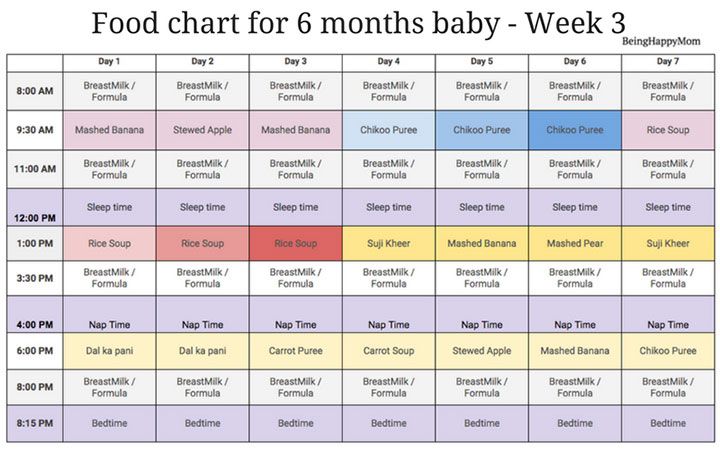 please mash the rice well and remove the pepper corns. You can also puree it.
please mash the rice well and remove the pepper corns. You can also puree it.
Curd rice. Puree if desired, skip tempering.
Curd oats
Moong dal halwa
Ragi idli
Baby food recipes for babies above 11 months
These need to be pureed before serving
Dalia khichdi
Oats vegetable khichdi
Sweet corn soup
Barley soup with vegetables
Chickpeas toddler food
Chickpeas soup (for babies above 15 months)
Badam milk. pls consult your doctor and use buffalo or goat milk, avoid cow’s milk.
Set dosa
Banana milkshake
Lassi (avoid salt and sugar)
Neer dosa
Kambu dosa
Sample Indian baby food recipes
Prep Time10 minutes
Cook Time20 minutes
Total Time30 minutes
Servings2
AuthorSwasthi
Ingredients for 6 months baby food recipes 1 – Any one of the following (refer notes)
- ▢ ½ banana
- ▢ 1 sapota
- ▢ ½ papaya
- ▢ 2 tbsp cooked rice
Ingredients for 7 to 8 months baby food recipes 2 (refer notes)
- ▢ 2 tbsp rice or 2 tbsps ragi or wheat flour
- ▢ 200 ml water
- ▢ 1 small apple or banana
- ▢ 1/8 tsp ghee homemade (refer notes)
Ingredients for 8 months baby food recipes 3
- ▢ 1½ tbsp rice aged rice
- ▢ 1½ tbsp dal (toor or moong dal)
- ▢ 1½ tbsp carrots chopped
- ▢ 200 ml water
- ▢ 1/8 tsp ghee homemade
Ingredients for 8 months baby food recipes 4
- ▢ 2 tbsp rice
- ▢ 1 baby potato or 2 tbsp chopped
- ▢ 1 pinch carom seeds powder (ajwain powder)
- ▢ ¼ tsp ghee homemade
Making 6 months baby food recipes
- ▢
Make sure you follow the 3 day test rule for every food you introduce.
 Wait for the results until 4th day.
Wait for the results until 4th day. - ▢
To make the baby food, Mash any one of the fruits – banana, papaya, sapota very well until smooth.
- ▢
If desired add it to a blender and puree until smooth. To thin down add a few spoons of boiled and cooled water. Fruit puree is ready.
- ▢
If using cooked rice, then puree together rice and any of the fruit – (banana, papaya, sapota or steamed apple) along with some boiled and cooled water. Fruit flavored rice is ready.
- ▢
You can also feed only steamed apple. Peel and chop the apples. Bring half cup water to a boil and add the apples to it.
- ▢
Cook until the apples are slightly tender just for a minute or 2. Cool and puree with rice or just the steamed apple. Apple puree is ready.
Making 7 months baby food recipes
- ▢
Wash rice and soak in water for at least 30 mins.
- ▢
Pressure cook on a medium flame for 2 to 3 whistles.
 You can also cook in a pot until soft.
You can also cook in a pot until soft. - ▢
Apple flavored rice cereal : When the pressure goes down, open the lid and add grated apple. Cover and cook for 2 to 3 mins. Cool and make a smooth puree. If needed add some boiled and cooled water. Add few drops of hot ghee. Apple flavored rice is ready.
- ▢
Banana rice cereal : Cool the rice completely. Add banana and rice to a blender and make a fine puree. Pour few tbsps boiled and cooled water if desired.
Making 8 months baby food recipes
- ▢
Wash rice and dal in a cooker or pot a few times until the water runs clear. Add grated carrots and pour water.
- ▢
Pressure cook for 2 to 3 whistles on a medium heat. If cooking in a pot add more water as needed.
- ▢
When the pressure goes down, using a masher mash the food to smooth. This is the stage you must be teaching you baby to eat mashed foods. Reduce feeding pureed foods. Add ghee to hot food and serve warm.
 Rice dal baby food is ready.
Rice dal baby food is ready.
Making 8 months baby food recipes
- ▢
Soak rice until water runs clear. Soak for 30 mins and cook along with potato until soft for 3 whistles. Mash the rice well and add ghee. Feed warm. To prevent colic you can add a pinch of ajwain powder. Potato rice is ready.
The nutrition values are only for the banana flavored rice. These are approximations only.
Please follow 3 day wait rule for every food you introduce.
Alternative quantities provided in the recipe card are for 1x only, original recipe.
For best results follow my detailed step-by-step photo instructions and tips above the recipe card.
Nutrition Facts
Baby food recipes
Amount Per Serving
Calories 45
% Daily Value*
Potassium 105mg3%
Carbohydrates 10g3%
Sugar 3g3%
Vitamin C 2.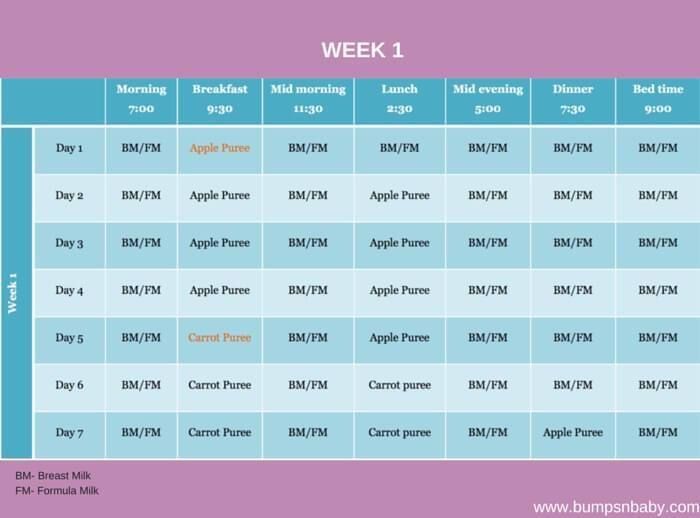 6mg3%
6mg3%
* Percent Daily Values are based on a 2000 calorie diet.
Tried this recipe?Mention @SwasthisRecipes or tag #swasthisrecipes!
© Swasthi’s Recipes
step by step
About Swasthi
I’m Swasthi Shreekanth, the recipe developer, food photographer & food writer behind Swasthi’s Recipes. My aim is to help you cook great Indian food with my time-tested recipes. After 2 decades of experience in practical Indian cooking I started this blog to help people cook better & more often at home. Whether you are a novice or an experienced cook I am sure Swasthi’s Recipes will assist you to enhance your cooking skills.
Follow Swasthi’s Recipes
Sign up to receive awesome Swasthi’s Recipes in your inbox *
Popular Recipes
Featured Recipes
diet for a 6-month-old baby with breast and artificial feeding, an approximate menu for a week in the table, a diet for a day
Published: 02/10/2021
Reading time: 4 min.
Number of reads: 184286
Author of the article: Ponomareva Yuliya Vladimirovna
Pediatrician, candidate of medical sciences, allergist-immunologist
Changes in a child in the first year of life are very rapid, and each month is not like another. The 6-month milestone is very important, it is largely evaluative and transitional. By this age, most babies have doubled their birth weight, are about 15 cm tall, and some babies have already erupted their teeth. The age of 6 months is also transitional in terms of nutrition. Breast milk or an adapted formula is still the basis of the diet, but with the beginning of the second half of life, all children, without exception, should begin to receive complementary foods. Despite the general graph of growth and weight gain and indicators of psychomotor development, the status and diet of children at 6 months can be very different.
Content: Hide
- The first feeding of 6 months
- The start of complementary foods at 4-5 months
- The second half of the life
- for a week for a child at 6 months
The first feeding of
If the baby is healthy and breastfed, and his mother eats a full and varied diet, exclusive breastfeeding is possible until this age.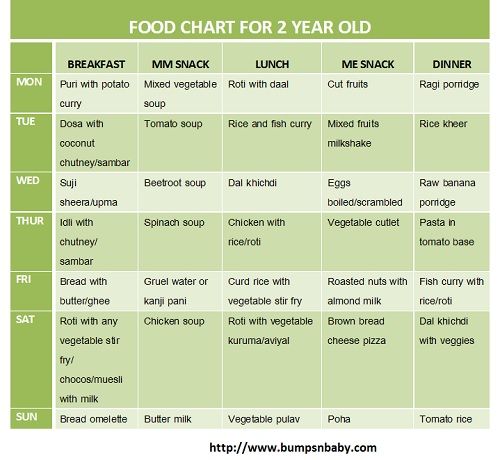 Cereal complementary foods in this case are preferable to start. This is due to the high energy and nutritional value of cereals, the ability to significantly enrich the baby's diet with a delayed start of the introduction of complementary foods.
Cereal complementary foods in this case are preferable to start. This is due to the high energy and nutritional value of cereals, the ability to significantly enrich the baby's diet with a delayed start of the introduction of complementary foods.
However, the rate of expansion of the child's diet in this situation will be accelerated. Before the 8th month of life, it is necessary to introduce all basic food groups into the baby’s menu, since in the second half of the year the need for additional intake of nutrients and micronutrients is very high. Another reason explaining the importance of the rapid introduction of complementary foods is the formation of immunity of the immune cells of the intestine to ordinary food. If a child is introduced to these foods at the age of 4-8 months, the risk of developing food allergies has been proven to be reduced.
Complementary feeding starts at 4-5 months
In today's life, the nutrition of a nursing mother, unfortunately, is not always complete.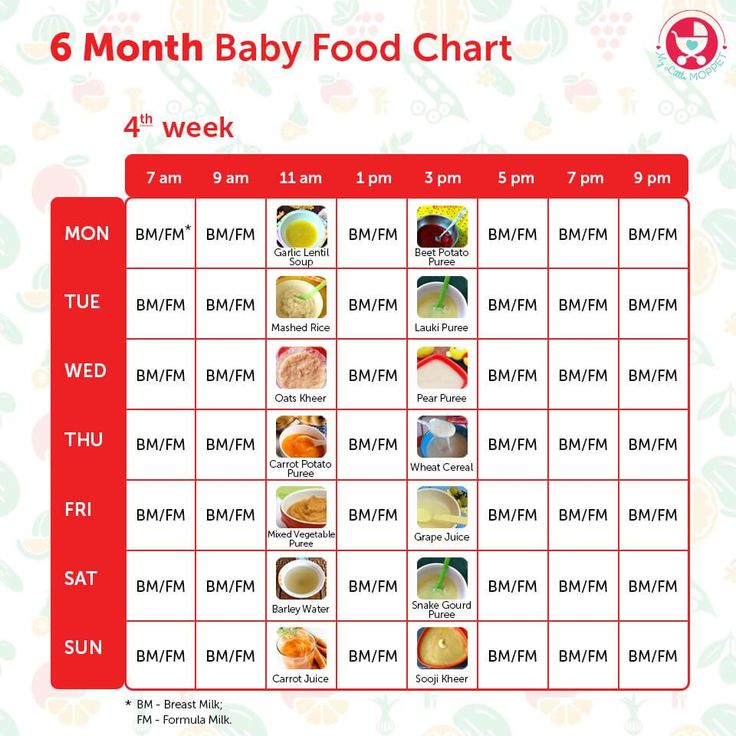 Therefore, for most breastfed babies, complementary foods already need to be introduced from 5 months in order to prevent deficient conditions.
Therefore, for most breastfed babies, complementary foods already need to be introduced from 5 months in order to prevent deficient conditions.
If a child is bottle-fed, then by the 4th month of life, the baby will not have enough adapted formula alone, and in this group of children, the timing of the introduction of complementary foods usually shifts a month earlier than in breast-fed babies. Accordingly, by 6 months, children will have vegetable puree and gluten-free porridge (buckwheat, corn and rice) in their diet. In the first half of life, monocomponent meals are used (that is, from one type of grain and vegetables), prepared on the basis of water, breast milk or an adapted mixture.
Fruit puree and juice can be another possible complementary food for children under 6 months of age without allergy symptoms. In a child with a risk of developing or manifesting allergies, the timing of the introduction of fruit complementary foods is shifted to the 8th month.
Second six months of life
Children over 6 months of age can supplement their diet with cereals containing gluten. First of all, these are oatmeal and wheat porridge, and then multi-cereal dishes with the addition of other cereals (millet, barley, rye). If the child does not have any manifestations of allergies, milk porridge can be included in the menu at this age. Bebi Premium industrial baby food products include specially prepared milk that is safe to use in healthy babies in the first year of life.
First of all, these are oatmeal and wheat porridge, and then multi-cereal dishes with the addition of other cereals (millet, barley, rye). If the child does not have any manifestations of allergies, milk porridge can be included in the menu at this age. Bebi Premium industrial baby food products include specially prepared milk that is safe to use in healthy babies in the first year of life.
From the age of 6 months, the baby's diet is expanded with such important products as meat and cottage cheese. These products are a source of high-quality protein, fats, and are also rich in minerals such as iron, calcium, and phosphorus. Pediatricians and nutritionists recommend introducing meat and cottage cheese as part of combined dishes based on a fruit and vegetable and / or grain component in a ratio of 1 (cottage cheese / meat): 4–5 (fruits / vegetables / cereals).
To enrich the diet with polyunsaturated fatty acids in the second half of the year, the menu includes vegetable oil in the amount of 3–5 grams per day, which can be added to the complementary food dish. The volume of each feeding is approximately 150-170 ml, and the child can already stand up to 3.5 hours between meals.
The volume of each feeding is approximately 150-170 ml, and the child can already stand up to 3.5 hours between meals.
In the table below, we offer a menu of 6 months for a week for a child who started receiving complementary foods at the age of 4-5 months, and by the time the second half of life begins, dairy-free gluten-free cereals, vegetable and fruit purees have already been introduced into his diet.
1st day
| Seeing | 0065 50|||
| Lunch (12.30) | vegetable soup with beef, olive oil | 100/30/3 | compot of drocked 9006, 9006 9 |
| Afternoon snack (16.00) | Plum puree with cottage cheese | 60/40 | |
| Breast milk/formula | 60 062 | ||
| food reception | menu | ml/g | |
| Early morning | breast milk/mixture | 150 | Milki | & Bashas Breakfast (09 cherry Bebi Premium» | 100 |
| 0065 Breast milk/mixture | 150 | ||
| children's soluble cookies "BEBIKI" Classic | |||
| GRUSHERS with rice and Claus | GRUSHIOUS WITH RISE and CRETURE 30 | ||
| Bebi Premium Kids Instant Herbal Tea | 50 | ||
| Bedtime 065 Breast milk/formula | 150 | ||
Rate the article
(Number of votes: 20, average 4.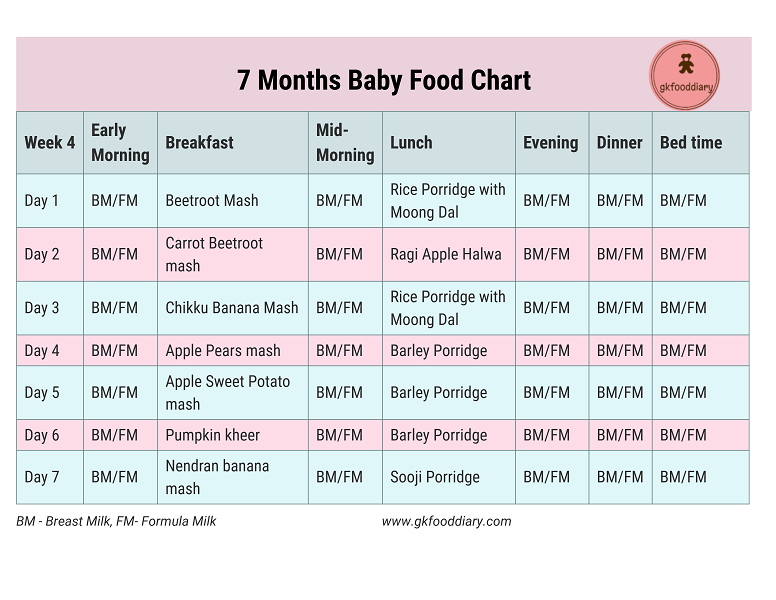 8)
8)
Share with friends:
Diet for a 4-6 month old baby
Your baby is already 4 months old. He has noticeably grown up, become more active, is interested in objects that fall into his field of vision, carefully examines and reaches for them. The emotional reactions of the child have become much richer: he joyfully smiles at all the people whom he often sees more and more often, makes various sounds.
You are still breastfeeding or have had to switch to formula or formula feeding. The child is actively growing, and only with breast milk or infant formula, he can no longer always get all the necessary nutrients. And that means it's time to think about complementary foods.
The optimal time to start its introduction is between 4 and 6 months, regardless of whether the baby is receiving breast milk or formula. This is the time when children respond best to new foods. Up to 4 months, the child is not yet ready to perceive and digest any other food.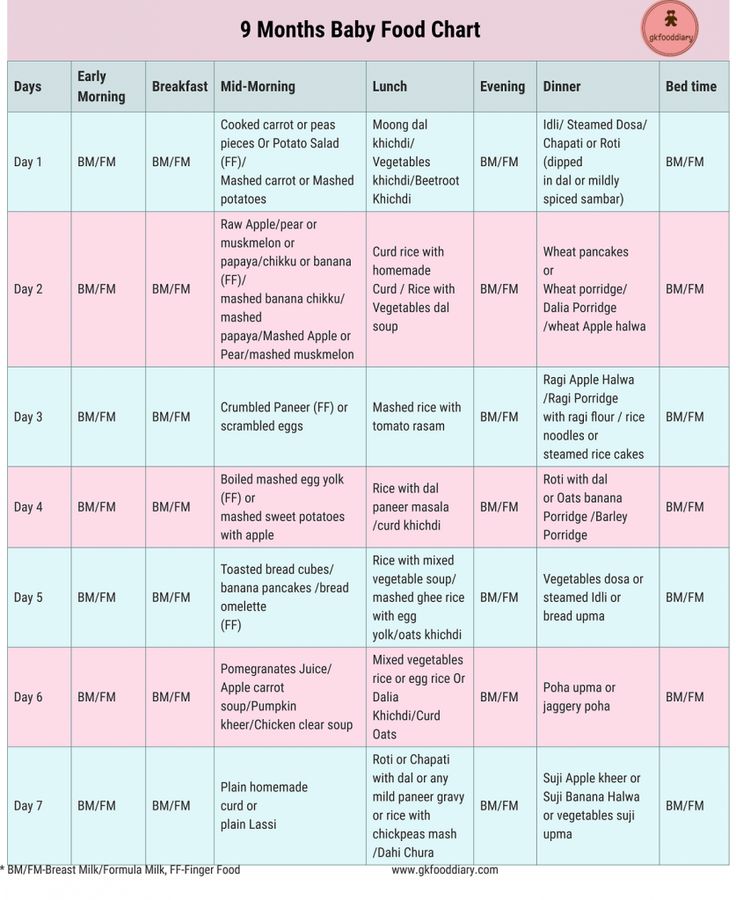 And with the late introduction of complementary foods - after 6 months, children already have significant deficiencies of individual nutrients and, first of all, micronutrients (minerals, vitamins, long-chain polyunsaturated fatty acids, etc.). In addition, toddlers at this age often refuse new foods, they have delayed development of chewing skills for thick foods, and inadequate eating habits are formed. It is important to know that, no matter how strange it may seem at first glance, with a delayed appointment of complementary foods, allergic reactions more often occur on them.
And with the late introduction of complementary foods - after 6 months, children already have significant deficiencies of individual nutrients and, first of all, micronutrients (minerals, vitamins, long-chain polyunsaturated fatty acids, etc.). In addition, toddlers at this age often refuse new foods, they have delayed development of chewing skills for thick foods, and inadequate eating habits are formed. It is important to know that, no matter how strange it may seem at first glance, with a delayed appointment of complementary foods, allergic reactions more often occur on them.
When is it advisable to introduce complementary foods as early as 4 months, and when can you wait until 5.5 or even 6 months? To resolve this issue, be sure to consult a pediatrician.
As a rule, at an earlier age (4 - 4.5 months), complementary foods are introduced to children at risk of developing iron deficiency anemia, as well as children with insufficient weight gain and with functional digestive disorders.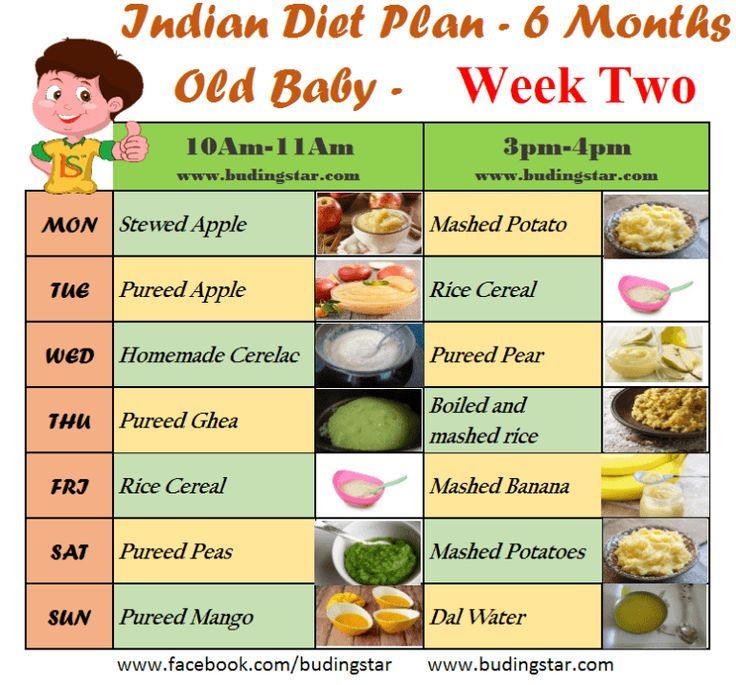
The optimal time to start complementary foods for a healthy baby is between 5 and 5.5 months of age.
The World Health Organization recommends that breastfed babies should be introduced to complementary foods from 6 months of age. From the point of view of domestic pediatricians, which is based on extensive practical experience and scientific research, this is possible only in cases where the child was born on time, without malnutrition (since in these cases the mineral reserves are very small), he is healthy, grows well and develops. In addition, the mother should also be healthy, eat well and use either specialized enriched foods for pregnant and lactating women, or vitamin and mineral complexes in courses. Such restrictions are associated with the depletion of iron stores even in a completely healthy child by 5-5.5 months of age and a significant increase in the risk of anemia in the absence of complementary foods rich or fortified with iron. There are other deficits as well.
The first complementary food can be vegetable puree or porridge, fruit puree is better to give the baby later - after tasty sweet fruits, children usually eat vegetable puree and cereals worse, often refuse them altogether.
Where is the best place to start? In cases where the child has a tendency to constipation or he puts on weight too quickly, preference should be given to vegetables. With a high probability of developing anemia, unstable stools and small weight gains - from baby cereals enriched with micronutrients. And if you started introducing complementary foods with cereals, then the second product will be vegetables and vice versa.
If the first complementary food is introduced at 6 months, it must be baby porridge enriched with iron and other minerals and vitamins, the intake of which with breast milk is no longer enough.
Another important complementary food product is mashed meat. It contains iron, which is easily absorbed. And adding meat to vegetables improves the absorption of iron from them. It is advisable to introduce meat puree to a child at the age of 6 months. Only the daily use of children's enriched porridge and meat puree can satisfy the needs of babies in iron, zinc and other micronutrients.
It is advisable to introduce meat puree to a child at the age of 6 months. Only the daily use of children's enriched porridge and meat puree can satisfy the needs of babies in iron, zinc and other micronutrients.
But it is better to introduce juices later, when the child already receives the main complementary foods - vegetables, cereals, meat and fruits. After all, complementary foods are needed so that the baby receives all the substances necessary for growth and development, and there are very few in their juices, including vitamins and minerals.
Juices should not be given between feedings, but after the child has eaten porridge or vegetables with meat puree, as well as for an afternoon snack. The habit of drinking juice between meals leads to frequent snacking in the future, a love of sweets is instilled, children have more tooth decay and an increased risk of obesity.
With the start of the introduction of complementary foods, the child is gradually transferred to a 5-time feeding regimen.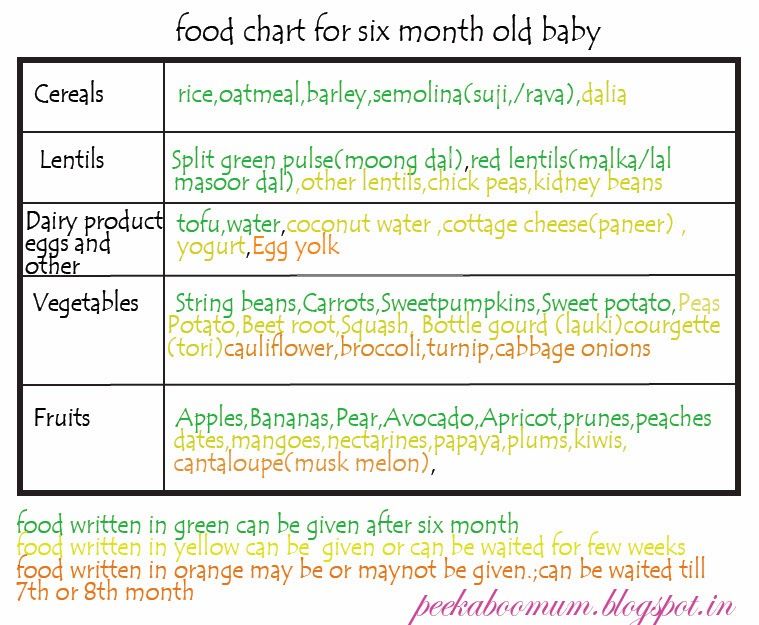
Rules for the introduction of complementary foods:
- preference should be given to baby products of industrial production, they are made from environmentally friendly raw materials, have a guaranteed composition and degree of grinding
- Complementary foods should be offered to the baby by spoon at the start of feeding, before breastfeeding (formula feeding)
- the volume of the product increases gradually, starting with ½ - 1 spoon, and in 7 - 10 days we bring it to the age norm, subsequent products within the same group (cereals from other cereals or new vegetables)
- can be entered faster, in 5 - 7 days
- start introduction with monocomponent products
- it is undesirable to give a new product in the afternoon, it is important to follow how the child reacts to it
- new products are not introduced in the event of acute illnesses, and before and immediately after prophylactic vaccination (should be abstained for several days)
When introducing a new type of complementary food, first try one product, gradually increasing its amount, and then gradually "dilute" this product with a new one. For example, vegetable complementary foods can be started with a teaspoon of zucchini puree. During the week, give the baby only this product, gradually increasing its volume. After a week, add a teaspoon of mashed broccoli or cauliflower to the zucchini puree and continue to increase the total volume every day. Vegetable puree from three types of vegetables will be optimal. The portion should correspond to the age norm. Over time, you can replace the introduced vegetables with others faster.
For example, vegetable complementary foods can be started with a teaspoon of zucchini puree. During the week, give the baby only this product, gradually increasing its volume. After a week, add a teaspoon of mashed broccoli or cauliflower to the zucchini puree and continue to increase the total volume every day. Vegetable puree from three types of vegetables will be optimal. The portion should correspond to the age norm. Over time, you can replace the introduced vegetables with others faster.
After the introduction of one vegetable (bringing its volume to the required amount), you can proceed to the intake of porridge, and diversify the vegetable diet later.
If the child did not like the dish, for example, broccoli, do not give up and continue to offer this vegetable in a small amount - 1-2 spoons daily, you can not even once, but 2-3 times before meals, and after 7 - 10, and sometimes 15 days, the baby will get used to the new taste. This diversifies the diet, will help to form the right taste habits in the baby.
Spoon-feeding should be done with patience and care. Forced feeding is unacceptable!
In the diet of healthy children, porridge is usually introduced after vegetables (with the exception of healthy breastfed children, when complementary foods are introduced from 6 months). It is better to start with dairy-free gluten-free cereals - buckwheat, corn, rice. At the same time, it is important to use porridge for baby food of industrial production, which contains a complex of vitamins and minerals. In addition, it is already ready for use, you just need to dilute it with breast milk or the mixture that the baby receives.
Children suffering from food allergies are introduced complementary foods at 5-5.5 months. The rules for the introduction of products are the same as for healthy children, in all cases it is introduced slowly and begins with hypoallergenic products. Be sure to take into account individual tolerance. The difference is only in the correction of the diet, taking into account the identified allergens.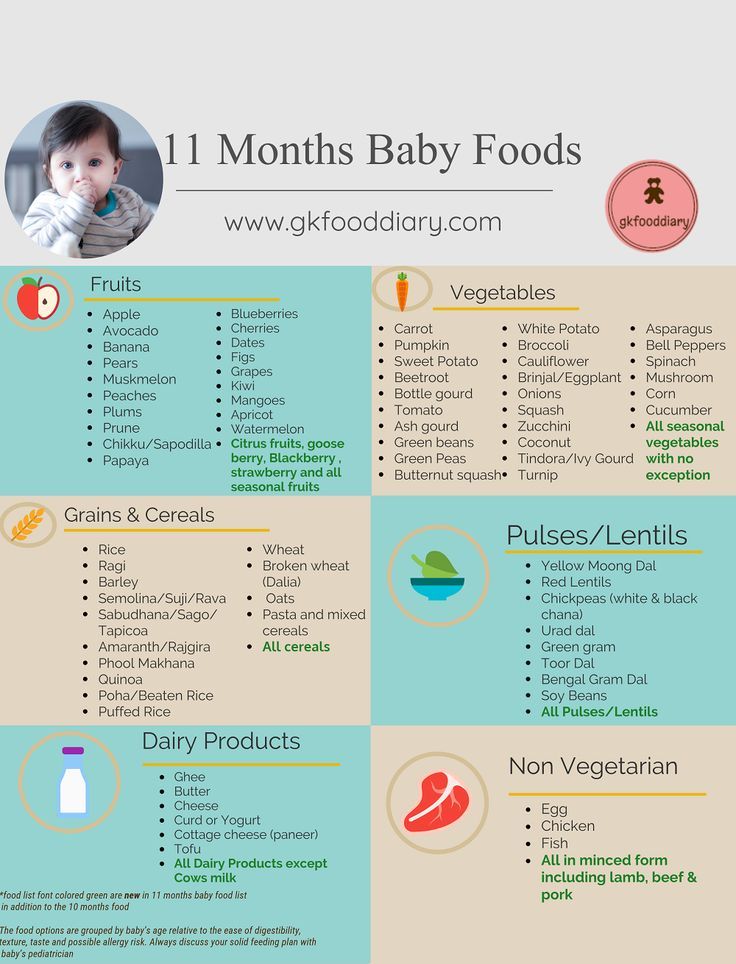 From meat products, preference should first be given to mashed turkey and rabbit.
From meat products, preference should first be given to mashed turkey and rabbit.
Diets for different age periods
Explain how you can make a diet, it is better to use a few examples that will help you navigate in compiling a menu specifically for your child.
From 5 months, the volume of one feeding is on average 200 ml.
Option 1.
If your baby started receiving complementary foods from 4-5 months, then at 6 months his diet should look like this:
| Breast milk or VHI* | 200 ml | |
| II feeding 10 hours | Dairy-free porridge** Supplementation with breast milk or VHI* | 150 g 50 ml |
| III feeding 14 hours | Vegetable puree Meat puree Vegetable oil Supplemental breast milk or VHI* | 150 g 5 - 30 g 1 tsp 30 ml |
| IV feeding 18 hours | Fruit puree Breast milk or VHI* | 60 g 140 ml |
| V feeding 22 hours | Breast milk or VHI* | 200 ml |
* - infant formula
** - diluted with breast milk or VHI
Option 2.
* - infant formula Option 3. : ** - diluted with breast milk Up to 7 months, increase the volume of porridge and vegetable puree to 150 g and introduce fruit puree. I feeding
6 hours Breast milk or VHI* 200 ml II feeding
10 hours Dairy-free porridge**
Fruit puree 150 g
20 g III feeding
14 hours Vegetable puree
Meat puree Vegetable oil
Fruit juice 150 g
5 - 30 g
1 tsp
60 ml IV feeding
18 hours Fruit puree
Breast milk or VHI* 40 g
140 ml V feeding
22 hours Breast milk or VHI* 200 ml
** - diluted with breast milk or VHI 
I feeding
6 hours Breast milk II feeding
10 hours Dairy-free porridge**
Breast milk supplement 100 g III feeding
14 hours Vegetable puree
Meat puree Vegetable oil
Breast milk supplement 100 g
5 - 30 g
1 tsp IV feeding
18 hours Breast milk V feeding
22 hours Breast milk 


